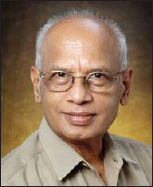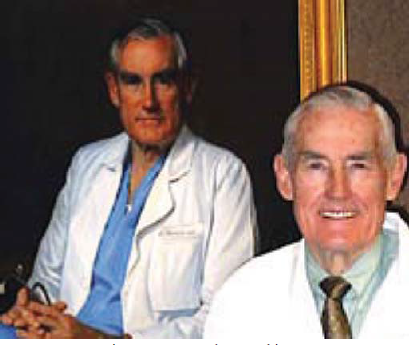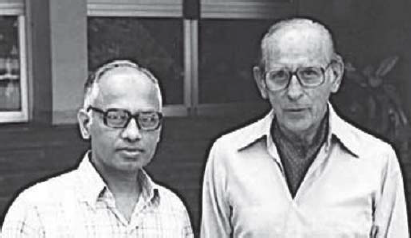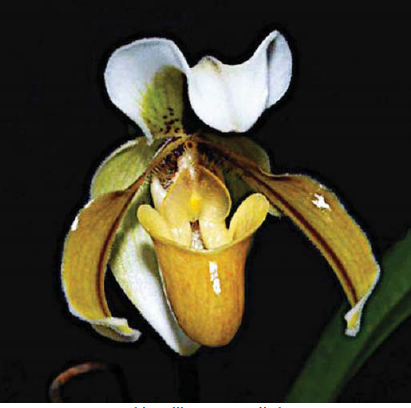Translate this page into:
Marthanda Varma Sankaran Valiathan (24 May 1934–17 July 2024)
[To cite: Pandya SK. Marthanda Varma Sankaran Valiathan (Obituary). Natl Med J India 2024;37:225–7. DOI: 10.25259/NMJI_937_2024]

THE NAME ‘VALIATHAN’
Valiathan is a title and is now a family name, held by a group of Nair families, all branches along the matrilineal line of the main Valiathan family, who are known as the Vattaparambil Valiathan. Maharaja Marthanda Varma of Travancore sought the help of the Vattaparambil, later Valiathan, family to overcome the powerful clan of Ettuveetil Pillamar, the Lords of the Eight Houses. The Maharaja addressed the oldest, and most powerful, lady of the Vattaparambil House as Valiyamma. Later the Lord of the Vattaparambil House died in battle against the Ettuveetil Pillamar, leaving the family without a head figure. When Marthanda Varma finally became king, he gave the title of Valiathan to the Vattaparambil family.
This is especially relevant as Dr Valiathan worked in the institution created by the family of Maharaja Marthanda Varma.
Childhood and education
He was born in Mavelikkara in the district of Alappuzha of Travancore State (now Kerala). In an interview he credited his parents for his interest in Sanskrit, Malayalam, English, music and ethical conduct. There were several physicians in his family. One of his uncles, Dr V.S. Valiathan, had studied in Edinburgh in 1902. He decided to follow in his footsteps.
After studying in the local school, he went to Trivandrum (now Thiruvananthapuram) where he studied science in University College. He was a member of the first batch of medical students in Trivandrum Medical College. He recalled the lesson on the pH of pus by Professor Thangavelu as an eye-opener.
His postgraduate studies were in Liverpool. He obtained the Fellowship of the Royal Colleges of Surgeons of Edinburgh and of England in 1960. He also obtained the MCh in Liverpool. During this period, he also worked on cirrhosis at Jefferson Medical College, Philadelphia. This is where he learnt of Dr John Heysham Gibbon’s historic development of the heart–lung machine.
On his return to India, he worked for a while on the faculty of the Postgraduate Institute of Medical Education and Research, Chandigarh. Wishing to specialize, he travelled to the Johns Hopkins Hospital in Baltimore, and Georgetown University Hospital in the USA for training in cardiac surgery. He was forever grateful to two mentors—Dr Vincent Gott and Dr Charles Hufnagel. Dr Gott, who had worked with Dr C. Walton Lillehei, had developed the first thrombo-resistant surface by ionic bonding of heparin for cardiovascular applications. Dr Hufnagel had made history by implanting a ball valve to treat aortic regurgitation in 1952, even before the advent of heart– lung bypass. They instilled in him the urge to innovate.
He obtained the Fellowship of the Royal College of Physicians and Surgeons in Canada.

- Dr Vincent Gott at Johns Hopkins, 2008

- Dr Charles Hufnagel with Dr Valiathan, 1985
Return to India
On returning to India in 1971, he could only obtain an ad-hoc appointment to the surgical staff of Safdarjung Hospital in Delhi and could do no cardiac surgery or research. Dr Hufnagel told him that he had made a mistake returning to India when he had a promising future in America. ‘The Indian virus will destroy you.’
Dr Valiathan took up an appointment as a Visiting Professor in the Indian Institute of Technology in Madras (now Chennai) but found he was spending most of his time in teaching.
Sree Chitra Tirunal Institute for Medical Sciences and Technology, Trivandrum
This is when he was invited by Mr Achutha Menon, Chief Minister of Kerala, to come to Trivandrum and take charge of the newly created Sree Chitra Medical Centre, intended to be a specialties hospital and teaching institution. The royal family of Travancore had gifted a multistoreyed building to the people and Government of Kerala in 1973. This was used to house the centre. It was close to the Trivandrum Medical College and Hospital but independent of them.
Mr P.N. Haksar, Deputy Chairman, Planning Commission, inaugurated the centre in 1976. As its first Director, Dr Valiathan developed facilities for the treatment of diseases of the cardiovascular and nervous systems. He set a high standard for those who followed him.
Dr Valiathan soon faced a problem plaguing all other cardiovascular surgeons in the country—a total dependence on foreign manufacturers for expensive cardiac valves and other devices. He and his team decided to design and make mechanical valves with a tilting-disc design. He started the Biomedical Technology Wing of the Sree Chitra Institute at the Satelmond Palace, on the banks of the river Karamana, nearly 11 km away from the hospital. This, too, was a gift from the royal family. It had been the official residence of Sethu Lakshmi Bayi when she was the Regent of the Kingdom of Travancore between 1924 and 1931. Sree Chitra Thirunal was just 12 years old then. Lakshmi Bayi had been nominated Regent as the Travancore royal family followed the matrilineal system.
The first three models of the mechanical valve did not meet his standards due to mechanical failures. ‘To our great relief, we succeeded in the fourth attempt. Now, Chitra-TTK valve has been in the market for over a decade. Monthly production of this valve by TTK Industries is over 1200 pieces and a portion of the production is being exported.’
‘Over the years, a series of other disposable devices were developed by our team. Meanwhile, my other team of surgical and scientific colleagues in the hospital has come out with a large surgical series for treatment of a serious heart muscle disease, namely endomyocardial fibrosis seen in the tropics. It is heartening that the two decades stint at Chitra fulfilled my long-cherished dream of combining cardiac surgery, scientific research and technology development in a flawless manner.’
The concept of amalgamating medical sciences and technology within a single institutional framework was regarded as sufficiently important by the Government of India led by Prime Minister Morarji Desai for it to be declared an Institute of National Importance. It was now named Sree Chitra Tirunal Institute for Medical Sciences and Technology, Trivandrum and placed under the Department of Science and Technology by an Act of Parliament.
As Director, he functioned under the Governing Body of the Institute. He ensured that the presidents of this body were farsighted, eminent scientists and statesmen.
On retiring from the institute in 1991, he was appointed the first Vice-Chancellor of Manipal University. He held this office till 1999.
Broad interests
As an example of the extent of his interests, let me narrate an attempt he made to improve the incomes of residents in Kerala. He was excited as he discussed this with me. He was actively exploring the cultivation of orchids in the favourable climate of the hills of Kerala. He referred to the tea and coffee plantations in Munnar and suggested that other hills such as Vythiri, Idukki, Vagamon, Thekkady and Wayanad could be considered for cultivating orchids. He consulted experts in the sub-Himalayan regions and others who could package and air-lift these delicate flowers to markets in western countries. His efforts appear to have borne fruit as an analysis by Santha and Mohanan in 2015 showed that there was a thriving trade. These authors, from the Department of Agricultural Economics, College of Agriculture, Vellayani pointed to ways and means by which profitability can be improved.

- Paphiopedilum M.S. Valiathan
Researchers at the Jawaharlal Nehru Tropical Botanic Garden and Research Institute, Trivandrum honoured Dr Valiathan by naming an orchid after him in 2008.
Medical ethics
As indicated above, the principles of ethical behaviour were ingrained in him at home. As he entered the world of medicine in India, he was troubled by the jettisoning of these principles by many members of the profession. His attempts at incorporating ethics as part of the curriculum bore fruit when, after his retirement as Vice-Chancellor, the Centre for Bioethics, Manipal Academy of Higher Education, Manipal was established in 2015. This centre now has five professors on its rolls.
In his essay in Current Science (1992), he took off from where Mr George Bernard Shaw had left off and revisited the doctor’s dilemma. He also referred in this essay to Dr Lewis Thomas’ classification of the three essentials of medical practice—to cure, to relieve and to comfort. While the entire essay deserves study, I call your attention to the final section titled ‘The ethical question’. I shall not rob you of the impact of this essay by disclosing any more details.
He returned to this subject again and again. The last reference I can find is his address to staff and students at the annual day function of Kasturba Medical College on 11 April 2015.
He was fond of referring to ethics in the three volumes he had produced. Here is a quote from one of them: ‘Ayurveda owes its call not to selfish goals or worldly pleasure, but to compassion for fellow beings. In seeking to know my legacy, you have but seen the leaves of a universal tree, too vast for your eyes. May your sight grow and your quest never end.’
Ayurveda and the history of medicine
In 1999, he was awarded a Senior Fellowship by the Homi Bhabha Council to pursue a study of Caraka under the respected ayurvedic physician and scholar, Sri Raghavan Thirumulpad in Kerala. He was in his 80s. ‘We discussed what I had understood, he would point out my mistakes and stress the need for greater clarity, brevity and elaboration. He was generous enough to share related ideas and his own experiences. For two and half years I used to visit him once in two months.’ This resulted in the publication of The Legacy of Caraka.
Later, as National Research Professor, he studied the work of Sushruta and Vagbhata and completed the series of Legacy volumes on the pillars of Ayurveda.
Dr Valiathan explained in an interview why he turned to Ayurveda, ‘I think that my upbringing in an Ayurveda-friendly environment has a lot to do with it. Our family used to consult a reputed Ayurvedic physician nearby for any illness except for those that warranted surgical intervention. However, through my active professional career in modern medicine, Ayurveda had disappeared from my sight only to resurface in the 1990s, a time when the feeling that nothing in my cardiac surgical practice, or indeed in the modern medicine, had been contributed to by an Indian started to dominate my thoughts. The fact that there had been no global contribution by an Indian in areas like causation of a disease, a drug, a surgical technique, a technology, a prophylactic regime in medicine disturbed my mind. I could not accept that originality in science was exclusive to white people. As I started my probe into the history of medicine in our country I was led to the life and times of scholarly sages—Charaka, Susruta, and Vagbhata.’
During the remaining years of his life he kept emphasizing that ayurveda is not only the mother of medicine but also of all life sciences in India. He strove for a common ground where physicists, chemists, immunologists and molecular biologists can interact with ayurvedic physicians. These are the interdisciplinary areas where advances would take place. He conducted seminars, workshops and delivered talks on this and related subjects.
He was especially fond of referring to ethics as it was taught by the three ayurvedic pioneers he had written about. In The Legacy of Caraka, he imagined the sage addressing our generation of physicians: ‘You would do well to remember that you are on new ground where knowledge is preferred to wisdom, where profit is confused with happiness and success is mistaken for triumph. You should look at where you are and where you are headed. Do not expect miracles of me. I have none to offer. I have left you a heritage which, though all-embracing, exists within a world of unknown reserves of knowledge, experience and faith. It behoves you to explore the trackless land, even as your forefathers did, and enhance your power to heal. But far from glorifying knowledge, you should celebrate good conduct, free from extremes and errors of judgement. Ayurveda owes its call not to selfish goals or worldly pleasure, but to compassion for fellow beings. In seeking to know my legacy, you have but seen the leaves of a universal tree, too vast for your eyes. May your sight grow and your quest never end.’
Accolades, awards
He was a respected member of several national academic organizations such as the Indian National Science Academy, Indian Academy of Sciences, Indian National Academy of Engineering, The World Academy of Sciences, American College of Cardiology, Royal College of Physicians of London, International Union of Societies of Biomaterials and Engineering and presided over some of them. He received numerous accolades and awards including the Padma Vibhushan (2005), Dr B.C. Roy National Award, the Jawaharlal Nehru Award, J.C. Bose Medal, and Dr Samuel P. Asper Award for International Medical Education from Johns Hopkins University. France honoured him by appointing him Chevalier of the Order of Palmes Académiques. He was Hunterian Professor of the Royal College of Surgeons of England.
I strongly recommend his autobiographical essay published in 2008. It contains a wealth of fascinating information on himself, his work and his values.
SUGGESTED READING
- www.agappe.com/in/blog-details/every-morning-brings-a-noble-chance-an-interview-with-dr-m-s-valiathan.html (accessed on 19 Jul 2024).
- Difficult ethical questions await future doctors: Valiathan. Available at www.thehindu.com/news/national/karnataka/difficult-ethical-questions-await-future-doctors-valiathan/article7103866.ece (accessed on 15 Sep 2024).
- [Google Scholar]
- Ethical issues in the practice of medicine. Indian J Chest Dis Allied Sci. 2006;48:7-11.
- [Google Scholar]




